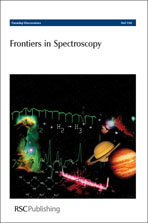Towards measuring the ionisation and dissociation energies of molecular hydrogen with sub-MHz accuracy
Abstract
The most precise determination of the ionisation and dissociation energies of molecular hydrogen H2 was carried out recently by measuring three intervals independently: the X → EF interval, the EF → n = 54p interval, and the electron binding energy of the n = 54p Rydberg state. The values of the ionisation and dissociation energies obtained for H2, and for HD and D2 in similar measurements, are in agreement with the results of the latest ab initio calculations [Piszczatowski et al., J. Chem. Theory Comput., 2009, 5, 3039; Pachucki and Komasa, Phys. Chem. Chem. Phys., 2010, 12, 9188] within the combined uncertainty limit of 30 MHz (0.001 cm−1). We report on a new determination of the electron binding energies of H2 Rydberg states with principal quantum numbers in the range n = 51–64 with a precision of better than 100 kHz using a combination of millimetre-wave
- This article is part of the themed collection: Frontiers in Spectroscopy

 Please wait while we load your content...
Please wait while we load your content...